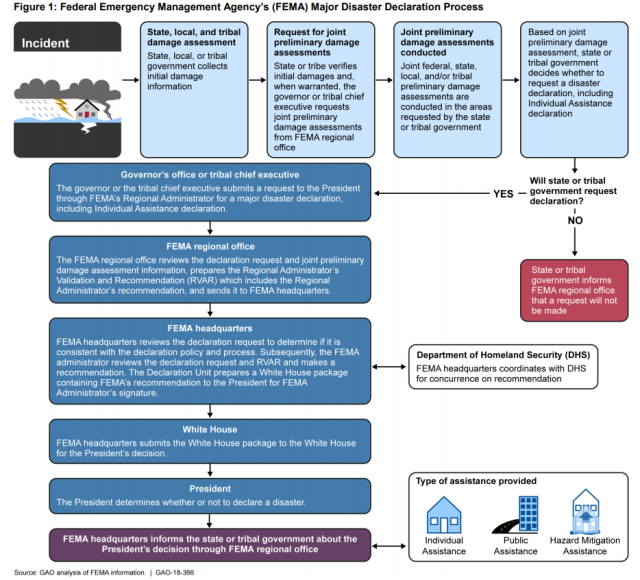Natural Disasters and FEMA’s Individual Assistance Program
- Direct assistance to individuals and families
- Crisis counseling
- Legal services
- Disaster case management
- Disaster unemployment assistance
- Degree of trauma to the community (e.g., injuries or deaths)
- Presence of special populations (e.g., low-income or elderly populations)
- Concentration of damages (e.g., the number of damaged homes)
- Availability of voluntary agency assistance
- Available insurance coverage
- Average amount of Individual Assistance by state
 FEMA received 294 declaration requests for Individual Assistance during 2008-2016. Of these requests, the President declared 168 disasters, and FEMA obligated about $8.6 billion in Individual Assistance to 46 states and territories.
FEMA received 294 declaration requests for Individual Assistance during 2008-2016. Of these requests, the President declared 168 disasters, and FEMA obligated about $8.6 billion in Individual Assistance to 46 states and territories.
 (Excerpted from GAO-18-366, click here for figure with notes)
Room for improvement
However, we reviewed FEMA’s Individual Assistance process and found that the regional offices did not consistently obtain and document information on all 6 of the factors when making recommendations. Doing so could help FEMA ensure it is achieving its stated goals in providing consistency in the evaluation process and in the types of factors it considers.
We recommended that FEMA evaluate why its regional offices are not fully documenting each element of the current Individual Assistance regulatory factors, and take corrective steps if necessary.
To learn more about the Individual Assistance process, check out the full report.
(Excerpted from GAO-18-366, click here for figure with notes)
Room for improvement
However, we reviewed FEMA’s Individual Assistance process and found that the regional offices did not consistently obtain and document information on all 6 of the factors when making recommendations. Doing so could help FEMA ensure it is achieving its stated goals in providing consistency in the evaluation process and in the types of factors it considers.
We recommended that FEMA evaluate why its regional offices are not fully documenting each element of the current Individual Assistance regulatory factors, and take corrective steps if necessary.
To learn more about the Individual Assistance process, check out the full report.
- Questions on the content of this post? Contact Chris Currie at curriec@gao.gov.
- Comments on GAO’s WatchBlog? Contact blog@gao.gov.

GAO's mission is to provide Congress with fact-based, nonpartisan information that can help improve federal government performance and ensure accountability for the benefit of the American people. GAO launched its WatchBlog in January, 2014, as part of its continuing effort to reach its audiences—Congress and the American people—where they are currently looking for information.
The blog format allows GAO to provide a little more context about its work than it can offer on its other social media platforms. Posts will tie GAO work to current events and the news; show how GAO’s work is affecting agencies or legislation; highlight reports, testimonies, and issue areas where GAO does work; and provide information about GAO itself, among other things.
Please send any feedback on GAO's WatchBlog to blog@gao.gov.
